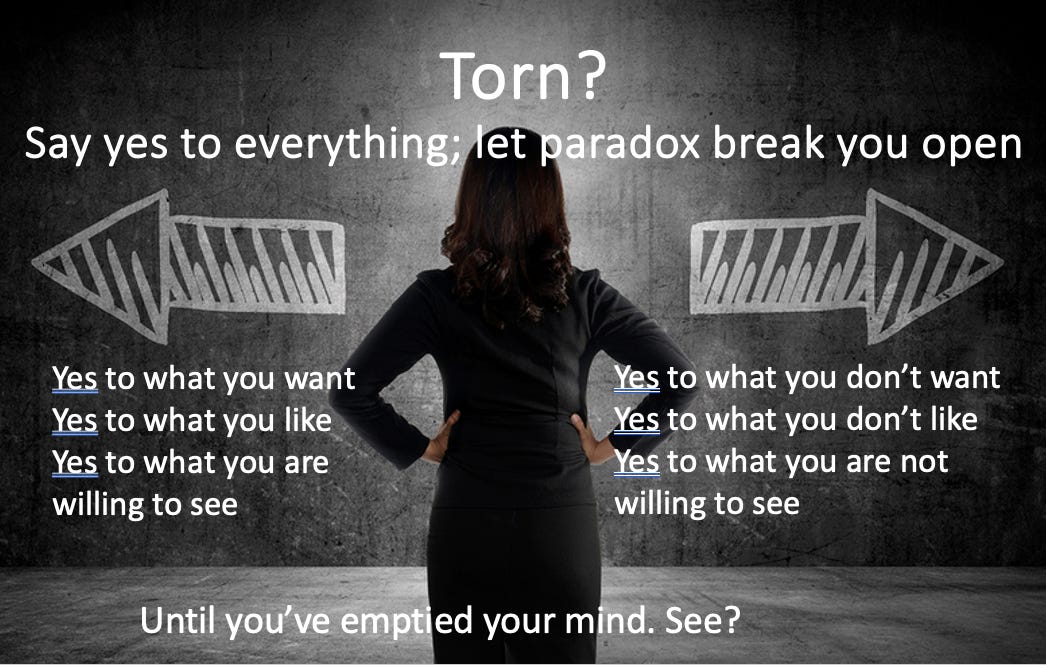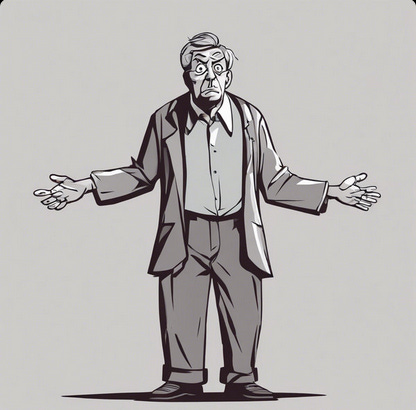It’s the 4th of July in the USA, a day of fireworks, hotdogs, and, oh yes, celebrating freedom.
It’s a good day to ask, “What, really, is freedom?”
We know, right?
It’s the declaration of independence.
It’s freedom from domination by the King – or any authority.
The freedom to be, do and have anything we want whenever we want because, “It’s a free country and you can’t stop me.”
It’s the freedom to make something of yourself.
It’s the freedom to move towards what you want and away from what you don’t want – be it a job, a marriage, a place that’s become too small for your ambitions.
It’s your tired, poor and hungry immigrants, yearning to be free, to have a chance at a better life.
It is the purple mountain’s majesty. The spacious skies. Your possibilities are endless.
It’s utterly intoxicating, and utterly missing the point.
What this spirit doesn’t consider are the natural - and chosen - limits necessary to keep freedom from going off the rails. Necessary limits are like a frame for a picture, a cup for your tea, the wheels on your car and the road they run on. It’s gravity. It’s physics and mechanics. It’s architecture. It’s contracts and laws. It’s Newton and Einstein and science itself.
Limits aren’t in the way, they are the way.
They are the shaping tools of freedom.
Ultimately, freedom lies only in timeless time. Here on earth, though, we must learn to be free in a world of limits, boundaries, and constraints.
Mastering (not overcoming) limits, liberates us.
As I said before on this Coming of Aging blog, I wrote a book that was never published. It was my magnum opus, written without the benefit of knowing much when I started. I thought it would change the world, but I couldn’t even get it out of the gate. I called it If I Live In A Free Country, Why Don’t I Feel Free.
It’s risky to share even a bit of it with you, because I was so devastated about the publisher withdrawing the contract. I lost faith. Utterly. But last weekend I told someone about it and she said,
“Have you written it?”
“Yes.”
“Well, publish it.”
“You don’t understand, it’s not fixable.”
“Run it through ChatGPT, tell them fix and publish it?”
“What???!!!”
So today, celebrating the 4th of July, I dug back in and found a section to share with you. I cut in in half. Rearranged it. Hmm. Not so bad. Now I can send it to Chat with clean underwear.
Everyday Koans
This is a tool from the book that I call Everyday Koans. It’s a way to liberate yourself when you are torn between “this but that”, between conflicting desires or directions.
How do you get out of the Chinese Finger Puzzle of this-but-that?
If you decide on A, you murder B. Choose B and it kills A. Notice that word de-cide. It’s in fact murdering the alternative, as in homo-cide and sui-cide and fratri-cide. Cide comes from the latin root caedere, which means cut or kill. Which option will you kill?
There are many ways to get off the horns of a this-but-that dilemma. It doesn’t have to be existential. You can simply de-cide on one horn or the other. There’s no freedom in that, but it resolves the indecision and let’s you get on with the day.
“Eeny-meeny-miny-mo” is just fine sometimes.
Asking 10 friends and then doing what you want also works. Wise or foolish, any choice made after talking to your friends will at least feel more comfortable.
Getting advice from a respected elder and then following it can work.
Even tossing a coin are relieves the tension of not knowing which way to go.
Or there’s the choice to not de-cide, to let circumstances make your choices.
Everyday Koans is a liberation tool.
They are designed not so much for de-ciding as for revealing the actual underpinnings of a choice and calling forth a latent capacity to see farther and deeper. Everyday Koans intensify what’s called cognitive dissonance, the unbearable feeling of inner conflict between this-but-that. Enduring such dissonance can draw you beyond what you think you know
Practicing freedom
How do we practice freedom, expand the space of freedom within which we feel live and express ourselves and contribute to the world without murdering the alternative?
Try this Everyday Koan practice.
Name your dilemma, your this-but-that.
Is it a person or situation? Is it one of those non-negotiables like gravity or death? Is it psychological – a fear of the consequence? Is it untested assumptions? Is it an ethical limit and the resistance is your conscience? Is it a cultural limit that you are squeamish to cross for fear of social exclusion? These are just a few obvious. Many constraints run our lives in the background, unnamed. They are just normal and invisible.
I want to run for public office, but my past will surely come back to haunt me. Buddhists say there is no God, Christians say there is – which way to enlightenment?
Pick one this-but-that that’s as monumental or as trivial as you like. Bring it to mind so you have something concrete to work with as you work through the exercise.
Stretch your arms out wide, like a shrug when you are confused, only wider. And wider still, until your two hands are in two different universes, unable to hear one another. Put “this” on one hand and “that” on the other. Name each clearly. This might take a while. You’ll feel a kerplunk of clarity when you’ve named the poles just right.
For example: Travel or Graduate School.
Travel will be exciting. I’ll learn what I could never learn in school. I’ll see beautiful landscapes and meet fascinating people. Yet, what if I lose the opportunities for continuing my education. I might get sick. My parents will reject me. My classmates may move on without me.
Grad School is exciting. I’ll master a profession, I’ll earn more money, I’ll be in positions of power. I’ll probably attract a better mate. Yet again, will I always wish I’d seen the world? Will I get stuck midway up the ladder and live a life of quiet desperation?
This-but-that.
Now describe them more fully in such a way that the tension of opposites increases. No premature common ground. No facile transcendence. This-and-that are really different. So different they can’t coexist in the same reality.
Now feel the options on one hand – while letting the other handle rest out of view.
You want to describe everything you want about it. Put that on your upturned hand. Then name everything you fear or hate about this option on the back of your hand. These aren’t in conflict. Each is just another thought about the choice.
Here are some questions to guide the inquiry:
What are you telling yourself about the situation?
What do you feel - in your body - when you think about it? Do your palms sweat. Do tears spring to your eyes. Does your heart sing?
Does the option make you angry, more furious than you’ve ever let yourself feel?
Do you feel like you might suffocate?
What will happen – or not happen – if that pole prevails?
What do you think about the people responsible for it?
Who are you wanting to protect? Convince?
How have you tried to change it? Make it better. Make it go away. Make it work?
What evidence do you have that supports the rightness of this pole? Statistics? Life experience? Advice from family, friends, lovers, counselors, coaches?
If you aren’t feeling anything yet, go back and do it again. You need to listen until every opinion or thought or longing has come to mind. You will feel the momentyou’ve said everything there is to say. You will feel empty and peaceful.
Then do the same with the other hand floating in space. What you like on your palm, what you fear or hate on the back of your hand. Exhaust all your thoughts about that option.
Holding two opposing ideas as both true is extremely uncomfortable. It creates pressure in the mind like hunger create pressure in the body – we seek with increasing intensity to reduce the discomfort. Most of the time, we will seek to make one pole wrong or less important so we can discard it and relax again.
Everyday Koans work with cognitive dissonance, a condition where both things can’t be true.
If you do this thoroughly, I guarantee you will feel a door open in your mind. You will pop out of cognitive dissonance because your conflict or question has evaporated. An option you’ve never thought of emerges. Your true desire, your soul’s true longing, for this quandary will become clear to you. It’s not a process of weighing options and picking. It’s a process of letting something beyond your ego speak.
Enduring dissonance in this way births possibilities.
Everyday Koans aren’t prescriptive. They offer a way to work with the automatic behavior associated with paradox and dissonance, allowing the drive for resolution to fire you right out of the dilemma and into… ahh, who knows!
Freedom isn’t a thing. It is the space in which you live, breathe and have your being.
There is no freedom in form, but we can learn to work with limits to liberate ourselves from what’s been holding us in, down or back.
True freedom is in the realm of spirit. It is outside of time and space. It is eternal.
Everyday Koans are a way to pop through the density of our lives to make a choice freely. I use this tool every day to open the way before me. To let my soul speak.
The big this-but-that for all of us
Think about our political moment on this 4th of July. Think about how polarized we are. Think about our distress about “the other candidate winning.” Think about the ideals in the declaration of independence versus this predicament we’re in. I don’t want to. I doubt you do. We want to de-cide and get on with it. Pick our pony and place our bet.
What if we put Biden on one hand and Trump on the other and engaged in the everyday Koan practice. What in the world might emerge from this?
Happy 4th of July. No better fireworks than this way of breaking the hold of this-but-that. But wait. I’ve got to get to the store for avocado dip, and then…




Brilliant! Crystal clear!💎 Love it dear Vicki💞
Love it!